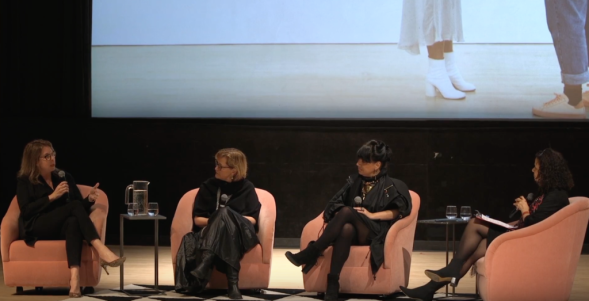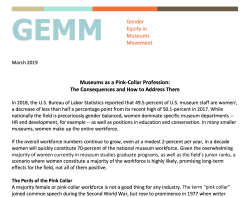If You Don’t Close the Museum Salary Gap, You Perpetuate It
Posted: February 10, 2020 Filed under: Museum, museum career, museum salaries, Museum wages, Nonprofit Leadership, Organizational Values, pay equity, Workplace Values | Tags: Leadership, museums, nonprofit, transparency 6 Comments
On February 6th, Kaywin Feldman, Director of the National Gallery of Art, was called out on Twitter when she said, “So I’m concerned about getting more men in our field.” Charlotte Burns (@charlieburns) couldn’t understand why one of the only women in the art museum world’s top ten leadership positions would suggest hiring men as a solution to the field’s salary issues. The answer is pink collar jobs, meaning those dominated by women, are those jobs where salaries do, in fact, escalate when men enter them. According to the Bureau of Labor Statistics, 49.5-percent of museum employees are women. And while Feldman’s remark seems counterintuitive, she’s correct. In fact, to bastardize Jane Austen, it’s a truth universally acknowledged that a single man entering a job sector dominated by females will be paid more and promoted faster than his female colleagues.
Why does this matter? First, a huge thank you to Feldman and her colleagues, Nathalie Bondil from the Montreal Museum of Fine Arts, and Anne Pasternak from the Brooklyn Museum, who spent February 4th in a sold-out discussion at the Brooklyn Museum titled “Women Leaders in the Arts.” There’s precious little time devoted to museum leadership as it is–and female leadership is rarely talked about except when it’s absent– so kudos to the Brooklyn Museum for hosting the event. But back to Feldman’s remark and working in a pink collar field. The museum field is trending toward pink collar. As a result, many of us have terrible salaries. That said, hiring men is the most common recipe for increasing pay.
What was missing from Feldman’s remarks was the fact that a small percentage of men in a pink collar field, don’t change anything. It takes decades and many more men before salaries go up overall. And guess what? Even then, there’s a gender pay gap because introducing men into a predominantly female ecosystem only accelerates the existing pay gap, something that’s been with us since the 1940s when women began to enter the museum field in significant numbers for the first time. Museum work, like many of the soft-skilled caring professions, paid less than manufacturing, business and science, but many women were new to the workforce, and frankly, just happy to be there. Unfortunately, starting behind keeps you behind and women never, ever caught up.
Women are also penalized because many take a career break for pregnancy, childcare, and/or care of a family member. According to the National Women’s Law Center (NWLC) working mothers make about 71¢ to a working father’s dollar, resulting in a loss of about $16,000 in earnings every year. (That’s white mothers though, the parenting pay gap is greater for women of color.) This parent gap exists in every state, and sadly, it doesn’t disappear when the kids leave, it stays with women until retirement, just like the gender pay gap we will hear about March 31, 2020, when white women’s pay reaches parity with white men’s. Women of color won’t reach parity until August 13th, Native women, October 1st, and Latina women November 2nd. How’s that for shocking and infuriating?
So kudos to all of you who have the salary question on your board’s agenda for 2020, but remember, no matter how generous your raises, if you don’t close the gap, you perpetuate it. So, instead….
If you’re a museum service organization or funder: Ask members sharing salary data to report on their pay gap, and be willing and ready to share pay data, including the gap, with prospective employees moving to your area.
If you’re a museum or heritage organization leader: If you currently ban employees from talking about wages, consider lifting it so staff can know what they don’t know. Think about a wage audit, disclosing the results to staff, and working to rectify them over a period of time. Work to eliminate bias in hiring and in promotion. Men, for example, are often rewarded monetarily when they become parents; men are also promoted on who they might become rather than on current performance.
If you’re a woman employee: Know what the field, particularly the museum and heritage field in your region, pays. Do your homework. Know what amount seems like pay Nirvana, and what amount is worth saying “Thank you, no.” Educate yourself on how much it will cost to live where you’re interviewing. (There are a number of Living Wage Calculators to help with this.) Always negotiate, and don’t let being over 50, when women’s wages really tank, or being under 30 when the wage gap is smallest, stop you. Need tips? Try AAUW’s Career & Workplace and Salary Negotiation workshop page or Gender Equity in Museums 5 Things You Need to Know.
Pay fairness is a moral issue. In the 1980s and 90s when women entered the job market in large numbers, it was possible to say, “She doesn’t have the experience, she’s not as educated, she’s not supporting a family,” or any number of out-dated and outmoded ideas. But that’s over. Fifty years ago, 58-percent of college students were men; today 56-percent are women. One in four women are raising children on their own; and 12-percent of working adults are also caring for another adult.
Your staff is the lifeblood of your organization. And a staff that’s equitably paid is a happy staff, and happy staffs deliver. They’re creative, empathetic, fun to work with, and great community ambassadors. Invest in them, and do it fairly.
Joan Baldwin
P.S. This was also the week that London’s Tate advertised for a head barista at a salary higher than the average curator. Cold comfort to know that we’re paid badly on both sides of the pond.
Image: Artnet News, February 5, 2020










I take some issue with your point about how women need to negotiate better salaries. First of all, because that puts the blame for low salaries onto the women themselves. But more to my point is that all of us who work in museums know that there just isn’t room for negotiation. Museums have tight budgets and even though “commensurate with experience” makes it sound like there is room to negotiate, the harsh truth is that there is definitely a cap to what a museum is willing to pay, and if you can’t take that salary, there are always plenty of other candidates who will.
Another way to look at it is that negotiating is self-advocating which is an important skill for all humans. An absence of negotiation isn’t the reason women’s salaries are low. Women’s salaries are low because museums and heritage organizations don’t pay enough, but like all relationships, the employer/employee one is a two-way street. Unless you’re the museum comptroller or business manager, don’t write the script for the organization, and do yourself and your sister colleagues a favor by advocating for what you need to live on. Yes, they can say no, and many do, but it’s worth asking especially if you’re applying for a new position. Nine times out of ten there’s money on the table to negotiate, and if you don’t ask in the sweet spot of being the one chosen out of all the others, you’ll never know.
While there is always a cap on what a museum is willing to pay for a given position, that cap is too often undefined, and left ambiguous under the “depending on experience” cloak. There are few experiences more disheartening than to get all the way through the search/interview process and have a museum offer you a job at a salary that you cannot afford to accept. You must decline, and both your time and theirs have been wasted. This is why it’s so important to list a pay range with every job posting. This allows prospective candidates to know where the salary floor and ceiling are, and to evaluate their financial situation to see if they can afford to work for pay within those constraints.
Museums who choose not to list pay ranges should ask themselves why that is. Is it because the pay is too low to attract good candidates? Is it because disclosing what a new hire will earn might upset existing employees who learn that their pay is less or expose a gender pay gap? If so, then perhaps it’s time to take a closer look at compensation and equity within the organization.
Good point, Michael. And this is why, from a gender point of view, it is particularly important that women applicants know whether a position is worth applying for. Thanks for adding to the discussion. I know this is a passion of yours.
[…] again. This morning I spent some time searching this blog for articles I’ve written about museum pay, from the gender pay gap, to the leadership pay gap, to questions about museum jobs and a living […]
[…] the Museum Salary Gap, You Perpetuate It.” Leadership Matters blog Posted: February 10, 2020 at https://leadershipmatters1213.wordpress.com/2020/02/10/if-you-dont-close-the-museum-salary-gap-you-p… (accessed 14 July […]